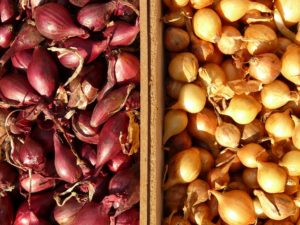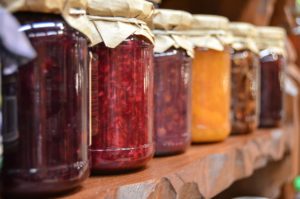-Pam Scott-

We are in full fall mode here at Fifth Season Gardening. We just received the mother lode of garlic, onions and shallots for fall planting. While unpacking these little gems I am reminded of the few pounds of shallots left in my fridge from the summer harvest. Since nothing in my house or garden gets done with any sense of moderation, each year I plant pounds of shallots and end up harvesting pounds and pounds and pounds of shallots.
Shallots are one of the more heavenly foods this earth has to offer. When I first tasted a shallot in a white wine rosemary butter reduction I thought I might faint (no exaggeration here). The intensity of the flavor fest in my mouth was something I had not been prepared for. Since then shallots have become one of my favorite kitchen ingredients. I make sure to plant lots of them and a few different varieties. The smaller French shallots have an intense almost herbal taste but they take some effort to peel. Because of this I also grow the larger varieties, they are easier to peel and have a more delicate taste for using raw.

I use shallots in my daily cooking to make simple vinaigrettes and marinades. I insert them into meats for roasting or just roast them with vegetables. They go into most of my pickles, chutneys and savory jellies. Despite all of these great ways to use an abundance of shallots, I still find myself with a pile of them that run the risk of going bad if I don’t use them (shallots don’t store as long as garlics and onions, so they must be refrigerated to keep them fresh). This is a perfect time to can up a batch of shallot marmalade. It’s a great way to have the intense flavor of shallots for using as a glaze for meats, vegetables, in salad dressings, or as a condiment for bread and cheese.
If you are not familiar with canning, it’s really pretty simple, but there are a few very important rules to follow. The most important thing to know about is…Clostridium Botulinum,aka,Botulism. This stuff can kill you. It’s a bacterium that grows in anaerobic, non-acidic environments. It is found naturally in soil and on produce. Canning, if not done properly, gives it the perfect environment to grow to toxic levels. The good news is that this bacterium is easily killed in a temperature range of 165-240 degrees for 10-12 minutes. This means the entire contents of the jar must come to that temperature for that long to be bacterium free. So here are your safe canning rules:
- You must use USDA approved jars and lids. No chips in the glass. Use fresh lids every time.
- If canning non-acidic foods or meats you must use a pressure canner, this is different from a pressure cooker.
- Sterilize all equipment that comes in contact with your food – boil all utensils, jars and tops for 10 minutes.
- Make sure your canning pot allows for 2″ of water above the jar and 2″ above that for boiling space.
- Make sure your jellies, jams or marmalades are hot when put into the jar for sealing.
- Leave 1/2″ of space at the top of the jar before sealing to account for expansion.
- Always use the USDA recommended boiling time as per your recipe when processing foods.
- Before serving home canned foods check for signs of spoilage; mold, discoloration, bad smell, a loose top or explosion upon opening.
Basically you want to eliminate bacteria, and if you are doing a hot water bath, your food must have a certain amount of acidity.
Here is my basic shallot marmalade recipe. You can create variations to this by spicing it up with rosemary, caraway seed, cumin seed or any herb or spice you want to experiment with.
Shallot Marmalade
- 1 pound shallots, peeled and sliced
- 2 T olive or vegetable oil
- 1/4 t sea salt
- A few grinds of pepper
- 1/4 cup packed brown sugar
- 2T honey
- 1/2 cup cider vinegar
- 1/3 cup chopped raisins
Sauté the shallots in the oil for 10 minutes or until soft.
Stir in salt, brown sugar, honey, vinegar and raisins. Cook while stirring until it becomes thick and syrupy, about 10 minutes. Put into 1/2 pint jars while hot, wipe rims with a moist clean towel, dry, seal with lids and put into a hot water bath for 10 minutes. Remove from bath and let cool on a wire rack or dish cloth.
Come on down to Fifth Season and check out our selection of shallots, garlics and onions, plus canning supplies and equipment. We have everything you need to enjoy your summer harvest throughout the year!

Geraldine Tollison says
Do you have any other recipes for storing shallots. Husband raised bumper crop now I got to figure out how to store them